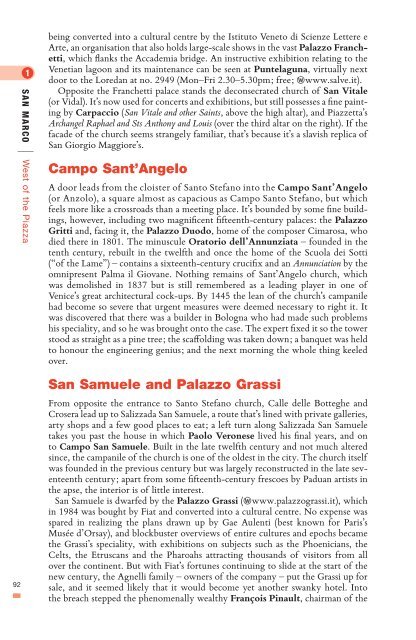You also want an ePaper? Increase the reach of your titles
YUMPU automatically turns print PDFs into web optimized ePapers that Google loves.
san marco<br />
|<br />
92<br />
West of <strong>the</strong> Piazza<br />
being converted in<strong>to</strong> a cultural centre by <strong>the</strong> Istitu<strong>to</strong> Vene<strong>to</strong> di Scienze Lettere e<br />
Arte, an organisation that also holds large-scale shows in <strong>the</strong> vast Palazzo Franchetti,<br />
which flanks <strong>the</strong> Accademia bridge. An instructive exhibition relating <strong>to</strong> <strong>the</strong><br />
Venetian lagoon <strong>and</strong> its maintenance can be seen at Puntelaguna, virtually next<br />
door <strong>to</strong> <strong>the</strong> Loredan at no. 2949 (Mon–Fri 2.30–5.30pm; free; wwww.salve.it).<br />
Opposite <strong>the</strong> Franchetti palace st<strong>and</strong>s <strong>the</strong> deconsecrated church of San Vitale<br />
(or Vidal). It’s now used for concerts <strong>and</strong> exhibitions, but still possesses a fine painting<br />
by Carpaccio (San Vitale <strong>and</strong> o<strong>the</strong>r Saints, above <strong>the</strong> high altar), <strong>and</strong> Piazzetta’s<br />
Archangel Raphael <strong>and</strong> Sts Anthony <strong>and</strong> Louis (over <strong>the</strong> third altar on <strong>the</strong> right). If <strong>the</strong><br />
facade of <strong>the</strong> church seems strangely familiar, that’s because it’s a slavish replica of<br />
San Giorgio Maggiore’s.<br />
Campo Sant’Angelo<br />
A door leads from <strong>the</strong> cloister of San<strong>to</strong> Stefano in<strong>to</strong> <strong>the</strong> Campo Sant’Angelo<br />
(or Anzolo), a square almost as capacious as Campo San<strong>to</strong> Stefano, but which<br />
feels more like a crossroads than a meeting place. It’s bounded by some fine buildings,<br />
however, including two magnificent fifteenth-century palaces: <strong>the</strong> Palazzo<br />
Gritti <strong>and</strong>, facing it, <strong>the</strong> Palazzo Duodo, home of <strong>the</strong> composer Cimarosa, who<br />
died <strong>the</strong>re in 1801. <strong>The</strong> minuscule Ora<strong>to</strong>rio dell’Annunziata – founded in <strong>the</strong><br />
tenth century, rebuilt in <strong>the</strong> twelfth <strong>and</strong> once <strong>the</strong> home of <strong>the</strong> Scuola dei Sotti<br />
(“of <strong>the</strong> Lame”) – contains a sixteenth-century crucifix <strong>and</strong> an Annunciation by <strong>the</strong><br />
omnipresent Palma il Giovane. Nothing remains of Sant’Angelo church, which<br />
was demolished in 1837 but is still remembered as a leading player in one of<br />
<strong>Venice</strong>’s great architectural cock-ups. By 1445 <strong>the</strong> lean of <strong>the</strong> church’s campanile<br />
had become so severe that urgent measures were deemed necessary <strong>to</strong> right it. It<br />
was discovered that <strong>the</strong>re was a builder in Bologna who had made such problems<br />
his speciality, <strong>and</strong> so he was brought on<strong>to</strong> <strong>the</strong> case. <strong>The</strong> expert fixed it so <strong>the</strong> <strong>to</strong>wer<br />
s<strong>to</strong>od as straight as a pine tree; <strong>the</strong> scaffolding was taken down; a banquet was held<br />
<strong>to</strong> honour <strong>the</strong> engineering genius; <strong>and</strong> <strong>the</strong> next morning <strong>the</strong> whole thing keeled<br />
over.<br />
San Samuele <strong>and</strong> Palazzo Grassi<br />
From opposite <strong>the</strong> entrance <strong>to</strong> San<strong>to</strong> Stefano church, Calle delle Botteghe <strong>and</strong><br />
Crosera lead up <strong>to</strong> Salizzada San Samuele, a route that’s lined with private galleries,<br />
arty shops <strong>and</strong> a few good places <strong>to</strong> eat; a left turn along Salizzada San Samuele<br />
takes you past <strong>the</strong> house in which Paolo Veronese lived his final years, <strong>and</strong> on<br />
<strong>to</strong> Campo San Samuele. Built in <strong>the</strong> late twelfth century <strong>and</strong> not much altered<br />
since, <strong>the</strong> campanile of <strong>the</strong> church is one of <strong>the</strong> oldest in <strong>the</strong> city. <strong>The</strong> church itself<br />
was founded in <strong>the</strong> previous century but was largely reconstructed in <strong>the</strong> late seventeenth<br />
century; apart from some fifteenth-century frescoes by Paduan artists in<br />
<strong>the</strong> apse, <strong>the</strong> interior is of little interest.<br />
San Samuele is dwarfed by <strong>the</strong> Palazzo Grassi (wwww.palazzograssi.it), which<br />
in 1984 was bought by Fiat <strong>and</strong> converted in<strong>to</strong> a cultural centre. No expense was<br />
spared in realizing <strong>the</strong> plans drawn up by Gae Aulenti (best known for Paris’s<br />
Musée d’Orsay), <strong>and</strong> blockbuster overviews of entire cultures <strong>and</strong> epochs became<br />
<strong>the</strong> Grassi’s speciality, with exhibitions on subjects such as <strong>the</strong> Phoenicians, <strong>the</strong><br />
Celts, <strong>the</strong> Etruscans <strong>and</strong> <strong>the</strong> Pharoahs attracting thous<strong>and</strong>s of visi<strong>to</strong>rs from all<br />
over <strong>the</strong> continent. But with Fiat’s fortunes continuing <strong>to</strong> slide at <strong>the</strong> start of <strong>the</strong><br />
new century, <strong>the</strong> Agnelli family – owners of <strong>the</strong> company – put <strong>the</strong> Grassi up for<br />
sale, <strong>and</strong> it seemed likely that it would become yet ano<strong>the</strong>r swanky hotel. In<strong>to</strong><br />
<strong>the</strong> breach stepped <strong>the</strong> phenomenally wealthy François Pinault, chairman of <strong>the</strong>







